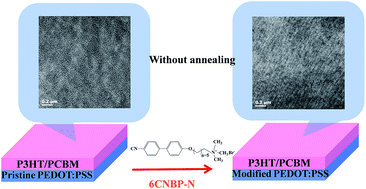Inducting effects of ionic liquid crystal modified-PEDOT:PSS on the performance of bulk heterojunction polymer solar cells†
Abstract
A type of ionic liquid crystals, 4′-(N,N,N-trimethyl ammonium bromide hexyloxy)-4-cyanobiphenyl (6CNBP-N), was synthesized and explored as a novel additive to modify the PEDOT:PSS anode buffer layer for P3HT:PCBM polymer solar cells (PSCs). Due to the ionic functions of 6CNBP-N, the amount of PEDOT on top surface of PEDOT:PSS was increased with increasing amount of 6CNBP-N, leading to a rougher surface and better conductivity. Most strikingly, when the 6CNBP-N modified PEDOT:PSS anode buffer layer was annealed at 150 °C (in the mesophase temperature region of 6CNBP-N), a more continuous network in the modified PEDOT:PSS film and more ordered microstructure and higher crystallization of P3HT in the overlying P3HT:PCBM active layer were formed, mainly induced by the self-assembling behavior of 6CNBP-N in its mesomorphism, thus favoring excition dissociation, charge transport and collection. Without undergoing the annealing of active layers, the power conversion efficiency (PCE) of 3.17% was obtained. Our results showed that the ionic liquid crystals, which combined the liquid crystal properties and ionic functions, were a promising additive for PEDOT:PSS, which could improve the properties of the PEDOT:PSS buffer layer and the overlying active layer at the same time, thereby enhancing the PCE of PSCs.


 Please wait while we load your content...
Please wait while we load your content...